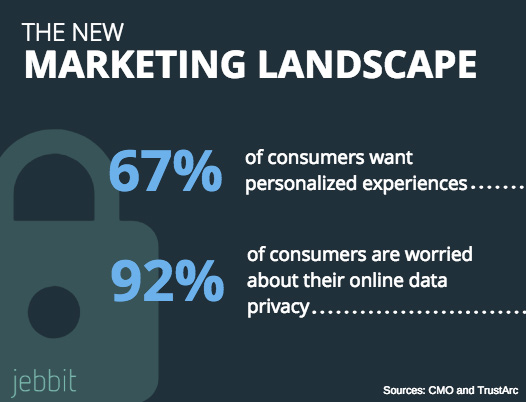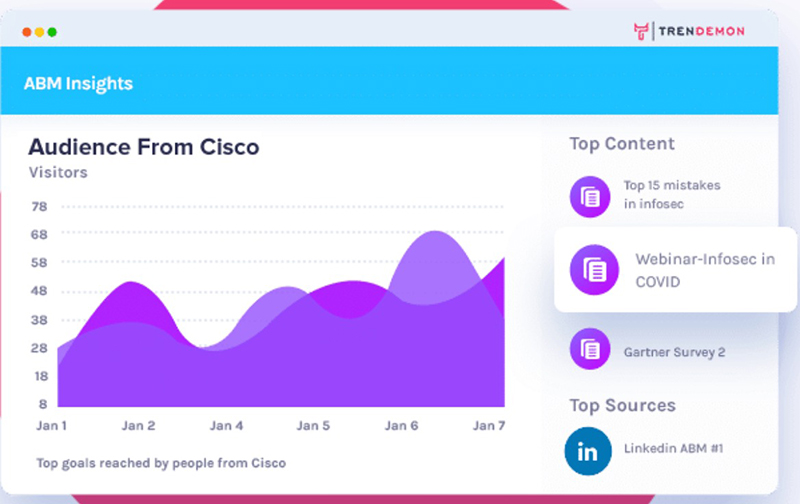
Marketing Personalization and Privacy: Can the Two Co-Exist?
The ability to hold two contradictory beliefs simultaneously is a sign of either wisdom or insanity, depending on whom you ask. Either way, it’s become a necessity for marketers. They have to contend with the fact that buyers are becoming more concerned about how their personal data is being harvested and used. While at the same time, they’ve come to expect—and even prefer—narrowly targeted, highly personalized marketing content. Reconciling these opposing attitudes is one of the biggest challenges for today’s B2B marketers, who have to stay engaging and relevant over the course of a long buyer’s journey.
In many markets, consumers’ feelings about data privacy take a back seat to regulations restricting its collection and use. Nevertheless, the need for personalization doesn’t go away. 80% of consumers are more likely to buy from a company that offers personalized experiences, and 42% actually get annoyed when marketing content isn’t personalized for them. Even when internet privacy laws limit what can be done with user data, marketers still have to figure out how to deliver compelling, personalized content.
Marketing personalization is learning everything you can about a customer, so you can figure out what they want and deliver it in a way that they’re most receptive to. For marketers, privacy regulations can feel like a brick wall cutting them off from the information they need to communicate with their audiences. At the same time, the potential for technology to mine and exploit personal data far outpaces the average person’s ability to understand and manage how much of their information is getting shared and with whom. It’s hard to argue against the case for regulatory oversight.
Personalized marketing can still succeed in a context where data is collected with the consumer’s consent and used in an ethical, responsible manner. When marketers embrace the contradictions, they may even find some unexpected synergy between these opposing forces.

Source: Jebbit: “5 Takeaways: Personalization vs. Privacy Paradox Report”
What is Marketing Personalization?
When companies compile facts and data about a customer and use that information to create customized content and experiences, that’s marketing personalization. Putting a customer’s first name in the subject line of a marketing email is personalization. So is sending the customer a text message when their location data indicates they’re near a store where they can buy your products. Personalization can fall on a spectrum between friendly and creepy, and it’s up to marketers to understand their audiences and know where to draw the line.
People are hardwired to enjoy recognition and familiarity. That’s probably the main reason why personalized marketing works, with 87% of marketers (PDF download) reporting that using it has led to a measurable lift in sales.
Buyers shed a lot of data when they venture online to research a purchase. The information collected and used for marketing can include things like their name and address, age, previous interactions with your brand, search history, the device they’re using, their current location, and more. Buyers who have interacted with salespeople or customer service may provide even more insights through conversational data. Regulations may limit what can be collected and put to use, but whatever remains can be leveraged to strengthen the buyer’s relationship with your brand.
How Marketers Use Data to Create Better Content, Products, and Experiences
That sense of recognition and familiarity that we innately desire makes us feel like we’re in control of what information we’re consuming – and that it isn’t an irrelevant waste of our time. The best forms of marketing personalization go far beyond just using the buyer’s first name or reminding them that their browsing and shopping habits are being scrutinized. Personalization works best when it takes the unique characteristics of the buyer into account and delivers something that speaks directly to their needs and interests.
The most effective personalization isn’t necessarily bespoke content created for specific buyers. Companies that do content marketing right often have deep libraries of articles, videos, and other resources that are relevant to their audience. The trick is figuring out which content to put to the fore and how to get buyers to click on it. Using compliant data in combination with real-time behavioral insights enables businesses to offer curated content experiences. This level of curation leaves the buyer feeling like they got exactly what they were looking for—but in a way that doesn’t feel like their privacy is being invaded.

Take, for example, a B2B company with a lengthy sales funnel. They know that their leads view a lot of content on their website before converting. Their challenge is getting leads to click on the right content at the right point in their buyer’s journey to keep them engaged. With data-driven customer profiles and real-time analytics, the company can queue up the right content at the right time and steer the leads toward it with personalized calls-to-action.
Tectonic Shifts in the Approach to Privacy and Data
Personalization can’t happen without data. But the data with the most significant potential from a marketing standpoint— such as the buyer’s browsing and shopping activities or their geolocation—can be the most sensitive in terms of privacy. It’s not hard to imagine how somebody’s search history or current whereabouts could be used for nefarious purposes. With these understandable concerns in mind, many countries have created strict new regulations for collecting and handling personal data.
It wasn’t so long ago that marketers had a more straightforward agenda: capture first, then convert. This was the guiding principle for both digital marketers. Leads would be sent to gated landing pages where they could trade their contact information for a fascinating new ebook. Field marketers camped out at trade shows and conferences could swap fun swag for business cards. But then, two major transitions took place:
GDPR
The first was the General Data Protection Regulation (GDPR), the sweeping set of digital privacy laws rolled out by the EU in 2016. The idea behind it was to prepare EU markets for the digital economy era by giving citizens more control over their personal data and establishing new rules for the organizations that collect and use that data. In 2018, compliance with the GDPR became mandatory. While the law only applies to the EU, the size and significance of the EU market have made the regulations highly influential worldwide.
COVID-19
The second transition occurred in 2020, with the entire world locked down and socially distanced due to the COVID-19 pandemic. Trade shows and other in-person events became a fond memory seemingly overnight. The huge conferences that marketers used to rely on for lead generation were suddenly off the calendar, precipitating a massive shift toward digital marketing.
On the consumer side, having to work, shop, and socialize online meant loosening up some of their concerns about sharing and privacy on the many new apps and platforms they were using. For businesses, the pandemic spurred increased investment in innovation, short-term strategies, and virtual events. Digital activities started taking up a much larger portion of marketing budgets, which led to a greater need to address the issue raised by the first transition: the rise of privacy as a major legal and operational challenge.
So, How Can Privacy and Personalization Co-Exist?
The bridge between privacy and personalization is dialogue. One of the GDPR’s key aspects (and of similar frameworks) is the requirement to obtain consent before harvesting and using an individual’s personal data. When a company wants to collect some personal data for marketing purposes, they are required to request the owner’s permission first, then inform them what information they are seeking and what they intend to do with it. The owner is allowed to opt-out or revoke their permission at any time.
As part of this dialogue of disclosing intentions and requesting consent, companies can ask for additional information, which they can use to create better experiences for the customer. This information doesn’t necessarily have to be “personal” or protected by the regulations.

Source: Jebbit: “5 Takeaways: Personalization vs. Privacy Paradox Report”
One way to do this is by using surveys to draw out this information. A series of simple but relevant questions can elicit a productive dialogue that fuels later personalization efforts. Surveying customers can reveal specific preferences that marketers can use to create more engaging content and calls-to-action. When companies are direct and transparent about the information they want from their customers, the customers are happy to oblige. 83% of customers say they would share their data in exchange for more personalized brand interactions.
Another way to optimize customer experiences without depending on regulated personal data is to curate content into categorized pools or hubs, making them more accessible to specific customer personas. Content hubs serve as a centralized repository for selected articles and media organized around a specific topic or theme. The curated content can include relevant external resources—an article from an industry expert, for example—as well as blog posts, whitepapers, and videos. Hubs created for specific industries, locations, or job roles can be served to the appropriate audiences at critical points in their buyer’s journey.
Ask, Listen, and Honor
The online privacy landscape has changed dramatically in recent years, with regulations tightening even as users grow more comfortable with surrendering data in exchange for a better ecommerce experience. Many companies are finding success by throwing out the old playbook and looking for ways to leverage data and technology in this new environment. Still, it’s crucial to comply with the applicable regulations and stay respectful of consumer concerns. Marketers who initiate dialogue with their audiences and really listen to their feedback are in the best position to connect and engage with potential buyers.
You don’t have to choose between personalization and privacy. It’s possible to provide buyers with the benefits of personalization—relevant content, enticing offers, genuinely helpful recommendations—without crossing any boundaries, legal or ethical, around the private data they want to protect. You just need to ask for their permission, listen to what they have to say, and honor their choices.



